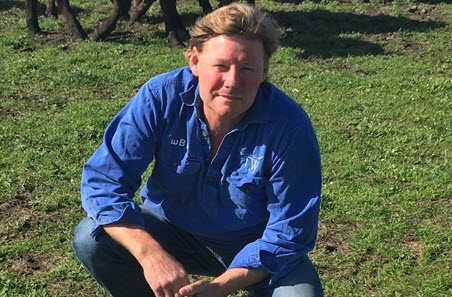Subscribe to The Weekly e-newsletter
For in-depth red meat market news, information and analysis.
Genetic selection with the market in mind
29 August 2018

ON-FARM SNAPSHOT
Name: Geoff Pearson (TW Pearson and Son)
Location: Myalup, WA
Area: 40,500ha
Enterprise: Beef breeding and lotfeeding
Livestock: Angus, cross-bred and Wagyu cattle
Pastures: Clover–ryegrass and forage crops
Soils: Coastal sand, gravel and clay
Rainfall: 450–900mm
LESSONS LEARNED
- Genetic selection has to be made with the market in mind.
- Maintain a rising plane of nutrition and wean early so cows can get back into condition.
- Low-stress stock management, regular handling and good yards contribute to beef eating quality.
Carcase competitions are an important benchmarking tool for large-scale commercial enterprises, such as the Pearson family’s extensive, integrated WA beef business.
Geoff Pearson oversees a 10,000-head breeding herd across 40,500ha along WA’s south-west coastline and a lotfeeding facility at Lake Preston, near Myalup.
He produces Angus, crossbred and Wagyu cattle for domestic and export markets, ranging from a 70-day product for the supermarket trade through to a 450-day, long-fed Wagyu program for export.
The enterprise is positioned to take advantage of the region’s mild coastal climate, reliable rainfall and proximity to agricultural zones for secure access to grain and fodder.
Geoff credits these environmental conditions, backed up with good genetics, as underpinning the region’s performance in the ANZ National Beef Carcase Competition, held in conjunction with this year’s Beef Australia .
The Pearsons were one of four WA beef producers (three from the south-west) to present category-winning pens of cattle in the national event, which is held every three years.
They entered three pens of home-bred Angus/Limousin steers, fed for 90–100 days at their Lake Preston feedlot.
As well as winning the grainfed heavy trade (260–340kg) category, their top pen received the Meat Standards Australia (MSA) Index Award for the three carcases with the highest total MSA Index. The Pearsons also received the MSA Index Award for the individual carcase with the highest MSA Index, coming in with 68.32.
Geoff uses the local, state and the national carcase competitions as a yardstick of herd performance, with the Beef Australia event providing a reference point with eastern production systems.
“For a commercial operation like ours, it is pleasing to see the performance of animals which are truly representative of our herd," he said.
He said producing an MSA-compliant product begins with the right genetics.
“We aim to buy bulls in the top 20% of breed characteristics, but any genetic selection has to be made with the market in mind,” Geoff said.
“Angus and Wagyu cattle are at opposite ends of the spectrum in terms of traits such as milk production, frame score and birth weight, but both have the potential to grade highly for their target market if managed appropriately.”
The Pearsons’ composite herd leverages the best of European and British breed traits to get a balance of mothering traits and yield, a mix which proved a winner in the national competition.
From the beginning
Management to meet market specifications, especially MSA compliance, begins from day one.
“We aim to keep our cattle on a rising plane of nutrition from the start so there are no setbacks," he said.
He starts with creep-feeding after calving, and said this access to supplementary nutrition is especially important with the Wagyu herd, as breeders can be poor milkers.
Calves are weaned early (Wagyus from 2–8 months and Angus from 6–9 months) so cows can get back into condition, supported by a good pasture base and grain supplementation.
Weaners receive a high protein grain mix, with the youngest receiving a 20% protein and 12MJ energy ration, which is reduced to 15% protein as they get older.
Oaten hay, canola meal, lupins and cereals fill the autumn feed gap and, depending on the season, Geoff will graze dual-purpose crops to maintain breeder nutrition.
“I believe it is important to have all aspects of our production system in line to meet MSA compliance,” Geoff said.
“Genetics and nutrition are the top priorities, but we back these up with training so our staff know how to handle cattle properly to reduce stress.
“In the feedlot, we recognise that different breeds have different temperaments and need to be managed appropriately. For example, the Wagyus need to be in small mobs so they settle better.
“It’s about working with cattle, not against them.”


